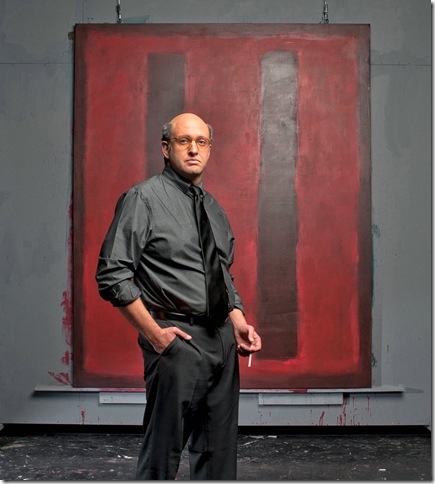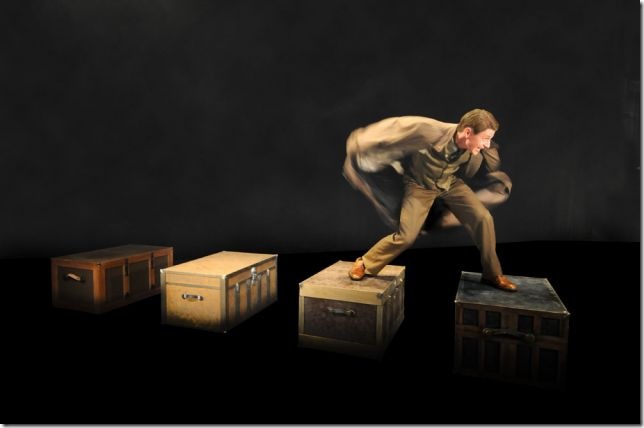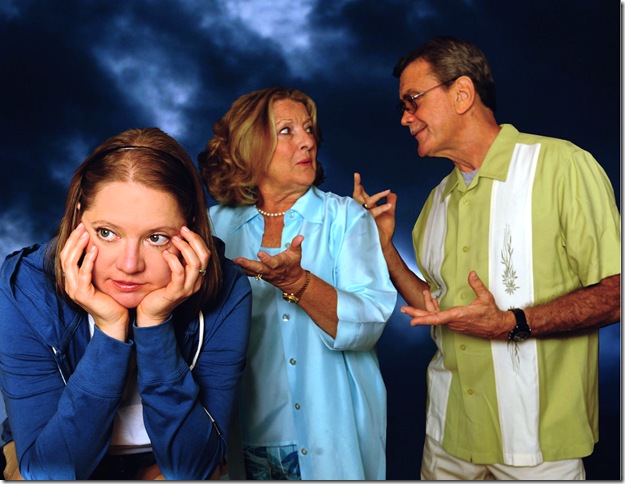“What do you see?” demands intense abstract expressionist painter Mark Rothko, referring to the massive red canvas with two darker red vertical lines that dominates the stage.
He is speaking to his new assistant, a would-be artist named simply Ken, hired to do all manner of grunt work, freeing up Rothko to ruminate, cogitate, bellow and, only occasionally, paint. And he is speaking to us, the audience at Coral Gable’s GableStage that has managed somehow to invade his New York studio, circa 1958, for an impromptu art master class.
The play is John Logan’s Red, the 2010 Tony Award-winning portrait of the artist as an underappreciated old man, a densely packed 80-minute biography and tutorial, a bracing torrent of words and ideas on the creative process. And while the evening at Coral Gable’s GableStage has minimal action, this journey into Rothko’s mind and soul never feels static, thanks to a verbally nimble, volcanic performance by Gregg Weiner and skillfully modulated, yet invisible direction by Joseph Adler.
Among the demons that are preying on Rothko at this point is a major commission from the new Four Seasons restaurant in the architecturally innovative Seagram’s Building. It is a recognition that would catapult Rothko into the forefront of the contemporary art world, even if his four massive murals will only be seen by the fat-cat capitalist diners that he so openly despises. The tension between art and commerce weighs heavily on Rothko, almost as much as the exact shade of red for his evolving work.
Logan is to be commended for not choosing to write a traditional biographical play, let alone a one-man show. Instead, he offers a snapshot in time, focusing on Rothko’s artistic philosophy rather than his life’s milestones. And the introduction of Ken, the empty vessel artist wannabe, motivates Rothko to verbalize his paranoid, judgmental and occasionally insightful views on his torturous profession.
Early on, Ken simply takes in his employer’s bilious pronouncements, including off-handed dismissals of other contemporary art such as Andy Warhol’s soup cans and Roy Lichtenstein’s comic books. Eventually, over the play’s two-year time span, Ken (and actor Ryan Didato) grow to the point that he challenges Rothko — the student rebelling against the teacher, the son against the surrogate father — on his opinionated positions.
With so much dialogue, brilliant as it is, the standout scene of Red is a short burst of furious action when the two of them speed-prime a vertical canvas, bobbing and weaving, covering the white void with a red that resembles dried blood. And then, just as quickly, they return to their verbal tug-of-war.
Red is that rare play that takes theatergoers inside the artist’s mind. It has been justifiably acclaimed and will be much produced this season in regional theaters across the country (including the Maltz Jupiter in February). It is compelling theater for visual art mavens and novices alike, and this GableStage production delivers its power, down to the last brawny brushstroke.
RED, GableStage at the Biltmore Hotel, 1200 Anastasia Avenue, Coral Gables. Through Sunday, Dec. 4. Tickets: $35 $50. Call: (305) 445-1119.
* * *
In the 1935 spy thriller The 39 Steps, an early work from a young Alfred Hitchcock, you can see the emerging work of the man who would be dubbed “the master of suspense.” Or, if you are Patrick Barlow, you can see a peripatetic tale ripe for spoofing.
With tongue planted firmly in cheek, adaptor Barlow conjures up a low-budget, yet foolhardy theater troupe that cannot afford the number of actors required to replicate Hitchcock’s tale of an innocent man accused of murder and forced to run for his life. Nor can they afford the many sets needed to represent the film’s profusion of locales. Still, none of that prevents them from forging ahead with a stage version of this very cinematic yarn.
So a mere four performers become dozens of characters before our eyes, thanks to the traditions of quick-change artists and probably an army of dressers working manically in the wings. As to the scenic requirements — the quick-cut to such locales as a London flat, a Scottish inn and a speeding train — they appear in a flash, thanks to the cast’s faux-improvising with found objects and props on the bare stage of the Maltz Jupiter Theatre.
As with Red, The 39 Steps is a popular choice on the not-for-profit circuit. The Maltz enlisted the aid of director Peter Amster, whose productions of the show have already played at three venues in the Northeast and Midwest. Still, this is treacherously thin material and sustaining the mirth for two hours — including a comic inertia-killing intermission — can prove very difficult.
That is the case at the Maltz, where the hilarity level seems about a quart low, despite four agile, energetic performers. Particularly adept at the requisite clowning are Andrew Sellon and Joe Foust, who handle most of the eye-blink character changes, most notably in a clever shtick where they keep transforming themselves with just the swap of head gear.
Beth Hylton has some fun with a succession of femme fatales and Christian Pedersen is the relative straight man, playing mustachioed Richard Hannay, the would-be killer being chased by the police and assorted spies. The plot is intentionally complex and some of the problem seems to be that director Amster is trying for narrative clarity at the expense of sheer speed. While that is usually a smart trade-off, it is a laugh-killer here.
The Maltz has become known for its production values, as it demonstrates with The 39 Steps, from Tracy Dorman’s breakaway costumes to Michael Lincoln’s crucial transitional lighting and particularly Victoria Deiorio’s music score, a humorous hommage to Bernard Hermann.
Still, this is a show whose only reason for being is to make us laugh. And by that measure, succeeding only now and then is not sufficient.
THE 39 STEPS, Maltz Jupiter Theatre, 1001 E. Indiantown Road, Jupiter. Through Sunday, Nov. 13. Tickets: $39 – $57. Phone: (561) 575-2223.
* * *
It is heartening to know that there is life after Florida Stage.
Carbonell Award winner Christopher Demos-Brown’s new script, Captiva, was scheduled to have its world premiere this season at the now-defunct West Palm Beach company. Fortunately, this dysfunctional family reunion play was quickly picked up by Miami’s fledgling Zoetic Stage where it is currently playing and receiving a vigorous, darkly comic production from the troupe’s acting ensemble.
If Demos-Brown’s earlier political drama When the Sun Shone Brighter did not convince you of this lawyer-turned-playwright’s talent, the versatility he shows with the vastly different Captiva should persuade you he is the real deal. (His third show, a police yarn called Our Lady of Allapattah, is booked to be unveiled at the Caldwell in Boca Raton in April.)
It is the tale of the once-tight Cestar clan, which has dispersed over time. Mom Emily (Barbara Bradshaw) and dad Tom (Bill Schwartz) have divorced and their three grown, 30-something offspring are all over the map in many ways. The youngest, Valerie (Kati Brazda) has relocated to California, hoping to break into the movies as a screenwriter. Middle child Luke (Nicholas Richberg) has escaped into academia where he continues to toil on a long-overdue book on poet Wallace Stevens.
And oldest of the three, caustic Matthew (Todd Allen Durkin) is the only married sibling, but that is not to be mistaken for maturity, as his half-hearted acceptance of the parenting chore for his heard-through-a-baby-monitor, but-not-seen toddler suggests.
All three Cestar sibs are smart and smart-mouthed, yet their return to the fold in Captiva, to a vacation rental of their youth, has a way of making them revert to adolescent alliances and attitudes. Val, 35, has initiated the gathering, ostensibly to introduce her fiancé to the family, but he has been delayed and there is a hurricane brewing, bearing down on Florida’s west coast.
So even those eager to leave, say, those miffed by Emily’s familiar, but still stinging verbal slights, cannot. As with most reunion plays, resentments soon surface and secrets are soon exposed. And when the storm hits, leaving the bungalow in the dark, that is the cue for climactic illumination.
In addition to the nuclear Cestars, there is Matt’s wife Nikki (Amy McKenna), in a state of perpetual exhaustion and feeling left out of the family’s tight inner circle. And there is patriarch Tom’s second wife Teresa (Amy Ione Alvarado), so inappropriately young that she went to high school with Luke.
Demos-Brown is adept at sketching each of these characters quickly, drawing the audience in to their frailties and quirks, and juggling all their stories with a seemingly effortless series of conversations and confrontations. He is well-aided by director Stuart Meltzer, who handles the considerable overlapping dialogue in a manner reminiscent of Robert Altman.
Of the play’s many exchanges, a standout is a Scrabble game interlude among the Cestar siblings. (Caution: Never challenge the wily Matthew when it comes to obscure Welsh words.) And despite the evident animosity between Emily and Tom, when they sit alone and reminisce about their earlier happy days, the scene strikes a simple, satisfying note.
Matthew is handed many of Captiva’s best lines, but Durkin certainly knows how to deliver them for maximum comic effect. Brazda is required to keep Val enigmatic, which works to her disadvantage in forging a concrete character, but she gains and retains audience empathy from the start. And for her non-musical debut, Alvarado manages to hold her own in this accomplished company.
Chances are you will see yourself and your family in the Cestars, a clan fueled by resentments, all too understandable. And after seeing Captiva, you are likely to seek out other work by Demos-Brown, as they surface both locally and nationally.
CAPTIVA, Zoetic Stage at Adrienne Arsht Center’s Carnival Studio Theatre, 1300 Biscayne Blvd., Miami. Through Nov. 20, Tickets: $40. Call: (305) 949-6722.
* * *
If at first you don’t succeed, most musicals cut their losses and accept defeat. But The Addams Family has such built-in audience appeal — probably from the television series of the ’60s or the movies of the ’90s, neither of which the stage show draws from — that its run on Broadway continues and a touring edition is picking up fans across the nation, despite earning extremely negative reviews in New York originally.
In fact, the show that is playing West Palm Beach’s Kravis Center this week is substantially revised from the one that opened at the Lunt-Fontanne Theatre in March 2010. And while it will never be confused for a great show, its three new songs, new narrative focus and new leading man make the tour version a genuine step up from the one now playing on Broadway.
The macabre clan created by cartoonist Charles Addams and first popularized in The New Yorker magazine are a ghoulish bunch who are blithely unaware that their world view is somewhat outside the norm. Still, when Marshall Brickman and Rick Elice (the duo that turned Jersey Boys into such a surprise hit) needed a story line, they pitted the Addamses and their dour Goth daughter Wednesday against the painfully conventional Beinekes of Ohio and their son, Wednesday’s beau, Lucas.
Wednesday is nervous about the two families meeting and embarrassed by her own family’s, um, peculiarities. If all of this reminds you of La Cage aux Folles or even Kaufman and Hart’s You Can’t Take It With You, rest assured that you are not alone.
Still, the show’s creative staff sensed a lack of a conflict between the two leading characters, Spanish lothario Gomez Addams and his slinky, if funereally gowned wife, Morticia. So the new version, a/k/a The Addams Family 2.0, has Wednesday imploring Gomez to keep from Morticia the news that Lucas has asked her to marry him. But Gomez claims he has never lied to Morticia and doing so would jeopardize their marriage. (Hey, I didn’t say the new plot was plausible, just that it was better than what existed previously.)
Most of Andrew Lippa’s musical score is fairly tune-challenged, but he does give Gomez a worthy 11 o’clock power ballad, Not Today. On Broadway, Nathan Lane was working overtime for laughs and not getting many. On tour, production supervisor — that is director, but without the title for contractual reasons — Jerry Zaks cast leading-man type Douglas Sills as Gomez and gets a more casual, less manic approach that reaps results.
Sara Gettelfinger is a fine foil to him as Morticia and you see a lot of her in Julian Crouch and Phelim McDermott’s black frock, “cut down to Venezuela.” Longtime Florida Stage followers may remember Blake Hammond, who won a Carbonell Award a decade ago as Alexander Woollcott in the musical At Wit’s End. Here he plays cuddly Uncle Fester, the show’s emotional center, whose zero-gravity serenade to the moon captures a surreal tone that the rest of the evening could have used.
Crouch and McDermott also supply the amusing scenery and Basil Twist adds a few touches of devilishly clever puppetry.
In all, though, The Addams Family is chiefly recommended to those interested in the mechanics of assembling a Broadway show and what to do when your first attempt comes up short. As to what is on view at the Kravis, it is demonstrably better than what its creators began with, but if you want a fully satisfying evening of musical theater, keep waiting.
THE ADDAMS FAMILY. Kravis Center Dreyfoos Hall, 701 Okeechobee Blvd., West Palm Beach. Through Sunday, Nov. 13. Tickets: $25 and up. Call: (561) 832-7469 or (800) 572-8471.



